Santa Maria de Vilabertran’s Augustine Cloister and the Scubertiade
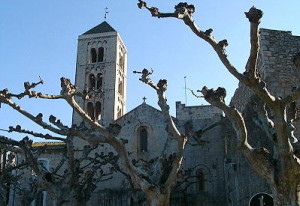
The Pyrenees and the Mediterranean have been the scene of world history for thousands of years. The foothills of the Pyrenees contain a rich treasure of historical monuments, as well as a large number of historic religious sites with a rich variety of sacred art. The church architecture developed after the Christianizing of the country from the third up to the fifth century and then gradually into the early Middle Ages and evolved into its own typical roman style. The Romanesque style has greater representation in Catalonia than the later Gothic style. After Catalonia ended its conflict with the Arabs in the year 985, and united with Aragón, it experienced an increase of power and enjoyed an unusually successful period. In addition, in the rest of Europe intensive building activity was developed under the authority of the Pope. Princes and clergyman worked together to spread the faith. The Benedictines were particularly active in spreading their Christianisation and culture program. Pilgrim routes connected the religious centres and along the way many more churches, monasteries, and lodgings were developed.
During this period of intensive building the Roman style was interspersed with regional styles and much of Europe began to show a more consistent image.
Medieval craftsmen wandered throughout Europe in search of work and spread the characteristics of the Romanic architecture, but each craftsman and each locale retained in every case some independence in style. The Spanish version of the Romanesque is characterized by smaller monumental size, clear building arrangement and simplicity in the decoration. There was expressive qualities of sculptures and wall paintings, but is missing the Refinement of the French school.
Rural small churches in the Pyrenees and Catalonia outnumber the large monumental monastery projects such as Sant Pere de Rodes or Santa Maria de Vilabertran, but these large regional projects serve as witness to the power and influence of the church.
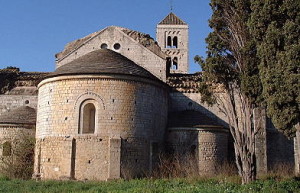 The former Augustine cloister Santa Maria de Vilabertran is an example of an outstanding and well-reconditioned cloister that was fully developed in the Romanesque form. Visitors note particularly how the interior of the church captivates by its clear space pattern and spaciousness and by the plain solid brickwork. The three-nave basilica with a short transverse and three Apsidal results in a high vault and the belt elbows, which arranges the area into yokes. The church is the oldest part of the monastery and was inaugurated in the year 1000. The exterior view is dominated by the solid three-floor bell tower in the Lombardy style. This Italy-inspired style is seen in the typical decorative breaking through of the towers by double windows and arcades, which diminish the image up of the defence brickwork. The Lombardy style was introduced and spread under the famous bishop Oliva (circa 1046) in Catalonia. The building of the monastery dates from the 12th to 14th Century, a boom time for the monastery, which expanded its influence under the protection of the princes Rocaberti and king Alfons I. The chapel for the Rocaberti tomb was added in the 14th Century and expanded the transverse nave of the church. An additional annex is the adjacent vestry and the chapel de Dolores, which dates back to the 18th century. In 1960, during renovation, a precious gold forging work, a silver cross, finely worked, was found. Possibly this jewel originates from a gift exchange on the occasion of the wedding of Jacob II with Blanca from Anjou, which took place 1295 in Vilabertran. At this occasion, the father the bride, Karl II of Naples, attended. This find is very rare, since the most important churches and monasteries were robbed of their decoration, what includes the taking or destruction of frescos, sculpture and gold forging work. They are in prominent museums throughout the world, but lucky for us a great deal can be viewed at the MNAC in Barcelona.
The former Augustine cloister Santa Maria de Vilabertran is an example of an outstanding and well-reconditioned cloister that was fully developed in the Romanesque form. Visitors note particularly how the interior of the church captivates by its clear space pattern and spaciousness and by the plain solid brickwork. The three-nave basilica with a short transverse and three Apsidal results in a high vault and the belt elbows, which arranges the area into yokes. The church is the oldest part of the monastery and was inaugurated in the year 1000. The exterior view is dominated by the solid three-floor bell tower in the Lombardy style. This Italy-inspired style is seen in the typical decorative breaking through of the towers by double windows and arcades, which diminish the image up of the defence brickwork. The Lombardy style was introduced and spread under the famous bishop Oliva (circa 1046) in Catalonia. The building of the monastery dates from the 12th to 14th Century, a boom time for the monastery, which expanded its influence under the protection of the princes Rocaberti and king Alfons I. The chapel for the Rocaberti tomb was added in the 14th Century and expanded the transverse nave of the church. An additional annex is the adjacent vestry and the chapel de Dolores, which dates back to the 18th century. In 1960, during renovation, a precious gold forging work, a silver cross, finely worked, was found. Possibly this jewel originates from a gift exchange on the occasion of the wedding of Jacob II with Blanca from Anjou, which took place 1295 in Vilabertran. At this occasion, the father the bride, Karl II of Naples, attended. This find is very rare, since the most important churches and monasteries were robbed of their decoration, what includes the taking or destruction of frescos, sculpture and gold forging work. They are in prominent museums throughout the world, but lucky for us a great deal can be viewed at the MNAC in Barcelona.
From the 1410 to 1431 the Abbott palace was built and the monastery and church were protected with new fortifications.
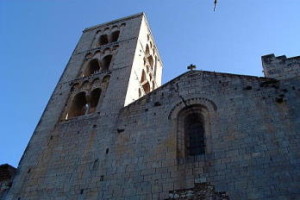 After the secularization of the parish churches in 1592 Vilabertran was transformed into a lay academy and experienced in the course of history different uses and, of course more damage. In 1794, for example it was taken by the French army and after the Spanish civil war, 1936-39, it was used as a military barracks.
After the secularization of the parish churches in 1592 Vilabertran was transformed into a lay academy and experienced in the course of history different uses and, of course more damage. In 1794, for example it was taken by the French army and after the Spanish civil war, 1936-39, it was used as a military barracks.
A union under the patronage of bishop Cartanyà of Girona in 1945 set as a goal the protection of the monastery. 1948 to 1955 saw important renovation work under the architect Pelagi Martinéz. In 1980 additional restoration was begun under the architect Bebet Cervera. Today we can admire Vilabertran as one of the best conserved medieval monastery complexes. And, as a bonus, the monastery offers a solemn venue for the Festival of classical music, the “Schubertiade”.
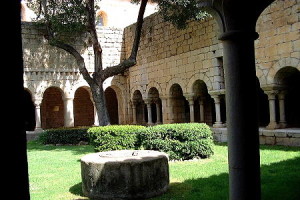 The “Schubertiade” takes place annually on five weekends in August and September in the Basilica of the monastery of Vilabertran. Works and songs of the Viennese composer Franz Schubert are offered by important international artists. The acoustics in the high area of the monastic church, the excellent musical quality and the medieval ambience make these evenings a special artistic experience.
The “Schubertiade” takes place annually on five weekends in August and September in the Basilica of the monastery of Vilabertran. Works and songs of the Viennese composer Franz Schubert are offered by important international artists. The acoustics in the high area of the monastic church, the excellent musical quality and the medieval ambience make these evenings a special artistic experience.
Before the concert, or during the intermission, take some time to explore the romantic cloister or to visit some of the monastery rooms. Throughout the year, but especially during the “Schubertiade” there are excellent art exhibitions in the monastery galleries.
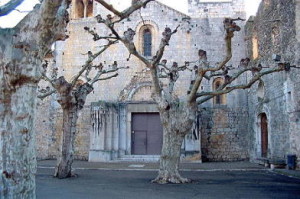 Town Hall:
Town Hall:
c/Comuners de Castella, 10
17760 Vilabertran, Girona
Tel. 972 505 902
Fax. 972 502 831
Mail: [email protected]
Web: www.vilabertran.com












